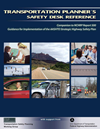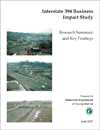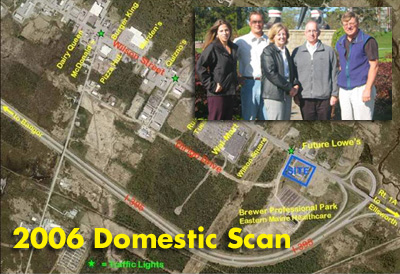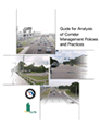Get InvolvedView Strategic Plan in .pdf document If you would like to get involved with our TRB Committee, please contact a subcommittee chair to volunteer your help with a current project. From there you may be asked to join the subcommittee, and then later asked to join the full committee. We need your help and welcome your participation! * Volunteer to serve as a reviewer of research papers, to work on a committee project, or to give a presentation or preside at a session of the annual meeting or a specialty conference. Last updated 1/11/13 |
Access Management Committee AHB70
Presentations from 2013 Annual Meeting
Session 201 - Access Management: A Left Is Not a Right
Access Management for Roadways in Abu Dhabi, United Arab Emirates
Philip Demosthenes, Philip B Demosthenes LLC, presenter P13-6456
Emerging Policy Issues in the Update of TRB Access Management Manual
Kristine M. Williams, University of South Florida, presenter P13-6458
Access Management and the Real World in South Africa
Hein Stander, BKS Pty, Ltd., South Africa, presenter P13-6460
Dealing with Perceptions of Negative Impacts to Market Value and Highest and Best Use Arising from Acquisition of Access Rights
Christopher Wayne Huffman, Huffman Corridor Consulting, LLC, presenter P13-6464
Session 672 - Safety and Implementation Impact of Access Management Research
Operational and Safety Effects of Using Left-Turn Lanes with Substandard Lengths at Unsignalized Median Openings: Case Study in Houston, Texas
Xiaoming Chen, Texas Southern University, presenter
Safety Analysis of Suburban Arterials in Shanghai, China
Xuesong Wang, Tongji University, China, presenter
Safety Evaluation of Access Management Policies and Techniques
Frank Gross, Vanasse Hangen Brustlin, Inc., presenter
Overview of the Draft Roadway Access Management Guidelines for Port Authority of New York and New Jersey
Alan Ginder, Port Authority of New York and New Jersey, presenter
Safety Effects of Access Points near Signalized Intersections (from 2012 Conference)
Reza Jafari, Road Safety and Transportation Solutions, Inc., presenter
View Schedule of events for 2013 Annual Meeting
- View Presentations from the 10th National Conference on Access Management July 17-19, 2012 in Dallas Texas
- The First International Conference on Access Management was held in Greece June 14-17, 2011
- A new website is under construction. See the beta version
New documents in Resources
Watch YouTube Video of Safe Access is Good for Business
View companion primer document
Two New Groups
 |
We are exploring access management social media solutions. In response, two sites have been created. Facebook and a new WordPress site |
For fans |
|
New site format |
WordPress |
Past Meetings
Access Management Committee Meeting in 2009
View presentations from the TRB 2008 Annual Meeting Sessions
Transportation Planner's Safety Desk Reference
 |
A very informative guide that assists planners in planning for safety on roadways that was passed out at the 2008 TRB annual conference in DC. |
Click here to view .pdf report (May 2007)
Interstate I-394 Business Impact Study
 |
This study attempts to capture the economic climate along the corridor both before and after conversion to a freeway. A variety of macro and micro level indicators were used to take snapshots of the corridor’s economic health both before and after freeway conversion.Click here to view .pdf report (June 2007) |
In Section 2.4 some of conclusions were:
- The economic impacts (mainly involving land development and business sales) of
transportation projects have not been researched as extensively as the safety and operational
impacts. - The business impacts studies that have been performed in states such as Florida, Iowa,
Kansas, and Texas have similarly concluded that businesspersons’ perceptions of the
impacts of changes in access on their companies are almost always worse than the actual
impacts as measured after the fact. - Before and after studies of transportation projects involving changes in access indicate that
such projects do not lead to significant increases in business failure rates. - Research also indicates that businesses along and near access-managed corridors do not
suffer inordinate retail sales losses. In fact, businesses along newly access-managed
corridors in Iowa actually outperformed other businesses in their communities in terms of
sales growth. - Literature on the impacts of transportation accessibility on land values suggests that such
impacts would be very difficult to demonstrate either in a positive or negative direction.
Variables such as parcel size and the overall location of the parcel would appear to matter
more.
Direct link to MnDOT Report http://www.olmweb.dot.state.mn.us/pdf/FINAL_I-394_Business_Impact_Study.pdf
Prepared by CH2M HILL and CTRE for MnDOT
 |
2006 Domestic ScanVIEW SUMMARY REPORTIn the fall of 2006, the Federal Highway Administration (FHWA) conducted a domestic access management scan tour. This document provides the results from the tour. FHWA funded the tour to focus attention on access management successes involving local jurisdictions. The scan tour provides good examples that demonstrate the role that local jurisdictions can play in coordinating their transportation planning, development review and permitting process, and comprehensive planning to achieve good access management outcomes. |
County Highway 42 provides a good example of how Dakota County is implementing access management.
The primary function of CH 42 is to accommodate the movement of through traffic (traffic using CH 42 to get to destinations outside of the corridor). However, the high level of commercial development along the corridor has generated large traffic volumes that have raised concerns regarding travel speeds, intersection delays, and motorist safety.
The plan provided a blue print for access management showing where access would be approved, denied, and alternative access provided.
Gateway 1 is an innovative land use and transportation planning project for the Route 1 corridor, from Brunswick to Prospect, Maine , involving approximately 21 towns along a 100 mile corridor. With the careful implementation of access management practices, Maine is preserving quality of life by balancing community growth and local values with transportation needs. Gateway 1 is an extensive project for Maine , and one tool being used is the Memorandum of Understanding. This memorandum was created to solicit agreement from all 21 towns to work together to develop a comprehensive long-range plan, including access management. All 21 towns signed the memorandum and are actively working together to implement access management along the Gateway 1 Corridor as part of this plan.
The City of Brewer , ME’s access management program has taken action in promoting traffic flow along their main corridor by providing for alternative access for local business, requiring shared accesses between businesses, and taking other alternative approaches to reduce any back ups and improve safety on the local roads.
Back to Top
10 Principles
Back to Top
State Websites
 |
Links to Access Management Materials from across the country click here |
Back to Top
Web site Comments, Questions, or Suggestions
Please contact Webmaster
Frank Broen (fbroen@teachamerica.com)
Teach America
121 N Love St
Quincy, FL 32351
(850) 875-0491
fax (850) 875-0490


